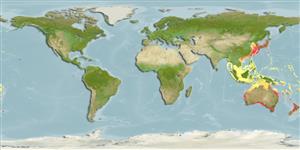Preferred temperature (Ref.
115969): 14 - 25.2, mean 17.4 (based on 293 cells).
Phylogenetic diversity index (Ref.
82804): PD
50 = 0.5156 [Uniqueness, from 0.5 = low to 2.0 = high].
Bayesian length-weight: a=0.02188 (0.01250 - 0.03829), b=2.97 (2.82 - 3.12), in cm Total Length, based on LWR estimates for this species & (Sub)family-body (Ref.
93245).
Trophic level (Ref.
69278): 3.6 ±0.2 se; based on diet studies.
Resilience (Ref.
120179): Low, minimum population doubling time 4.5 - 14 years (tmax=11).
Prior r = 0.36, 95% CL = 0.24 - 0.54, Based on 5 stock assessments.
Fishing Vulnerability (Ref.
59153): High to very high vulnerability (69 of 100).
Climate Vulnerability (Ref.
125649): High vulnerability (60 of 100).
